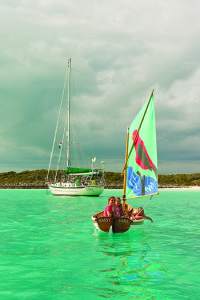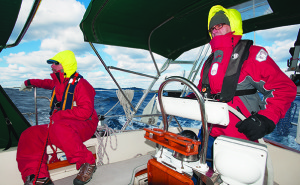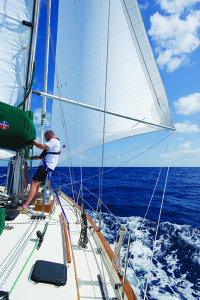Why don’t sailors sail anymore? (published March 2012)
Nassau, 0900 hours. After picking up Curt Hewett, who will help me during the offshore passage to North Carolina, we raise the sails, weigh anchor and head westward out of Nassau Harbour. Noticing the stir we’re creating and all the cameras aimed at us as we approach the crowded cruise ship docks under full sail, I steer close, enabling everyone to admire Worthless Wench, my Pacific Seacraft 40. Acknowledging the crowd with just the proper amount of aloofness, we head out to North Providence channel.

People love sailboats. The romance of being moved by nothing but air seems somehow magical, while the perceived danger of being at sea awakens the adventurer in many of us. In the late 70s, when I lived in England, I was captivated by a television series called “The Onedin Line” starring a young, very gorgeous Jane Seymour. The series, set in Liverpool from 1860 to 1866, portrayed life at sea in such an exciting fashion that it strongly influenced my desire to learn to sail.
We see sailboats everywhere. Ads for financial management companies, pharmaceutical products, airlines and travel agencies capitalize on the romance and fascination of sailing. Songwriters rhapsodize about “Red Sails in the Sunset” and countless books and movies glorify the days of traveling under sail. The beauty of a boat carrying a full press of sails is difficult to describe.
In his classic Two Years Before the Mast, Richard Henry Dana, Jr. manages to express how awe-inspiring a ship under full sail can be: “One night while we were in the tropics, I went out to the end of the flying jib-boom, upon some duty, and, having finished it, turned around, and lay over the boom for a long time admiring the sight before me… and, there, rose up from the water, supported by only the small black hull, a pyramid of canvass (sic), spreading out far beyond the hull and towering up almost, as it seemed in the indistinct night air, to the clouds. …I was so lost in the sight, that I forgot the presence of the man who came out with me, until he said…half to himself…How quietly they do their work!”
MOTHER NATURE’S CALL
I was enjoying a sundowner at the town docks in Washington, NC with my friend Richard Simpson, comparing notes on our recent travels. I had just returned from three-and-a-half months in the Bahamas. Rich, by himself, had gone all the way to Honduras.
“Beaufort to Guanaja, Honduras in 14-and-a-half days,” he said enthusiastically. “I only motored the last two hours—I was running out of daylight.”
I nodded, quietly watching the sun set behind the Highway 17 Bridge. Just seven days earlier, a sailboat owner in Marsh Harbour had insisted that he could make it home to North Carolina in 72 hours. I looked out at his 42-foot Beneteau, somewhat puzzled. Knowing a little about hull speeds and the vagaries of wind and currents on a passage of some 480 miles, I told him I typically calculated an average of 120 to 140 nautical miles a day, taking into account wind shifts, light air and unfavorable currents. “We don’t worry about that,” he said. “We put up the sails and run the motor. ”
Oh? I thought. Is this really why we do this? A sailboat is a pretty inefficient way to travel. A typical cruising yacht moves at a speed between a fast walk and a slow bicycle ride. If your motivation is to get from point A to point B as quickly as possible, why do it on a sailboat? The larger question is, if you’ve taken the time to go cruising, just how quickly do you really need to move from one place to the next?
True, guests sometimes need to be ferried to and from the airport at a set time, and prudent seamanship may occasionally require moving out of the way of dangerous weather when there is no wind. Typically, though, when I’m sailing, I find myself in a zone of mental stillness in which I make decisions based on what Mother Nature might be serving up.
The morning Curt and I left Nassau, I had planned to sail to Eleuthera, anchor for the night and cross into the Abacos the next morning. The wind, however, had other plans. As we cleared Nassau, it went light and shifted to the northeast, basically blowing directly from where we were going.
“We’re going to sail this,” Curt and I agreed. The seas were flat. We sheeted the jib in tight, centered the boom and sheeted the main to just keep all telltales flying. Wedging ourselves into the corner of the cockpit, we steered to the genoa’s telltales. Because of the concentration required, Curt and I each took two one-hour shifts at the helm until the wind decided to fill in. At 1800, sliding smartly through the water, we engaged the autopilot, enjoyed a relaxing dinner and watched the setting sun paint the water in colors an artist would be hard-pressed to replicate.
We agreed that it made sense to skip Eleuthera and continue overnight directly to the Abacos. Arriving at Little Harbour just as the sun cleared the horizon, our sail turned out to be a win-win negotiation with Mother Nature—same result, different way to get there—with a sunset and a sunrise thrown in for good measure.
I find it ironic that in spite of the attention sailboats attract and the sense of accomplishment one feels after a successful sail, I see very few billowing sails in some of the world’s most spectacular cruising grounds. I do see lots of boats with bare sticks, or one sail up, telltale water spewing out of the engine’s exhaust, transiting the “waypoint highway” at impossible angles in a virtually non-existent breeze; in essence, power yachts with auxiliary sails. People seem to wait until the wind dies before they decide to move their boats. Tacking is pretty well out of the question.
It appears as if many sailboat owners aren’t interested in utilizing their vessels to their full potential, or have simply grown so apathetic that it’s too much trouble to really sail their boats.
Shortly after I bought my first boat, I signed up for a class on racing trim with North U and asked a fellow sailor if he wanted to join me and share expenses for the trip to Norfolk, where the class would be held. “I’m a cruiser, not a racer,” he told me. “I don’t need to learn about sail trim.”
FOR THE SAKE OF SAILING
“I see a miracle. That’s a code phrase we use on the radio when we actually see a sailboat sailing,” said a sport fisherman to Rich Simpson at the dock in Cape May late last summer.
Rich had left Chesapeake City earlier that day in the company of eight boats, but was the only one who had not turned the ignition key, instead choosing, in his words, “a lovely sail down the Delaware River.”

The week prior, I had the midnight to 0300 watch 200 miles off the South Carolina coast. My crew and I had been battling counter currents, fairly large seas from a storm system in New England and inconsistent winds. Worthless Wench just didn’t feel right as I took the helm. She felt all bound up as if she were fighting herself, laboring at 3.5 knots SOG. I began experimenting with sail trim and found that with each change, she gradually opened up and began to get some spring back in her step. Soon we were making 5 to 5.5 knots.
As we settled in, I decided to let the next watch have an extra hour of sleep. I was enjoying the sail so much I almost felt guilty for not sharing, but wanted to savor the moment a bit longer. Looking out at the night sky, I began to ponder the disconnect between sailing and people who travel around on sailboats. To me, the true essence of sailing is mindfulness, not hurrying from one place to the next. To quote the late Bill Crealock, “The passage itself should be one of the pleasures of the cruise.”
Many would-be-sailors have fallen victim to the malaise that has become so damaging to us, as humans, on both a personal and a societal level: the inability to live in the moment. Wresting what we can from an already overtaxed environment, we seem compelled to rush from place to place, never taking time to live in the spaces between. Numbing our minds with television and other electronic distractions precludes thinking and learning. Racing from anchorage to anchorage under power keeps us from connecting with the environment. Running kids from soccer practice to music lessons is not really spending time with them, just as motorsailing is not really sailing.

To me, the essence of sailing lies in the space created between the beginning and the end of the journey; all the good stuff you miss while your motor runs. Just as in personal relationships, it’s not the beginning or the end of the journey, but what you do with the space in the middle that counts.
Captain Jeff Armor, who runs Different Drum Sailing Adventures, recently hosted a group of students from CLC (Connecticut Experiential Learning Center) on a weeklong trip in the Chesapeake aboard Boundless, a 46-foot cutter/ketch. Melinda Alcosser, one of the teacher/chaperones, posted this account of the first four days of their trip on the Different Drum Blog:
“We all cheered as we once again became powered by the wind. Living with the elements as they are and in the moment, we are not wedded to any schedule but our own. We plan for the day, navigate a course, yet know that we may decide to alter the plan depending on what the day brings. Sailing is at once incredibly peaceful and thrilling. Truth is present at all times. Moving via wind power necessitates working with physics and nature, remaining flexible, adaptable, courageous and being ready for anything. It enlivens the spirit. …for our CELCers, this may be one of the few times in their lives to be away from the hustle-and-bustle of a plugged-in, fast-paced society, with hours to simply be.”
Sometimes, it seems, we just need to look at what’s been given us through someone else’s eyes.
A former Olympic bicycle racer, Bill Kund is a commercial photographer based in North Carolina or on his boat—wherever assignments take him. To “stay current,” he sails Worthless Wench, his Pacific Seacraft 40, as far and often as his schedule allows. www.billkund.com















